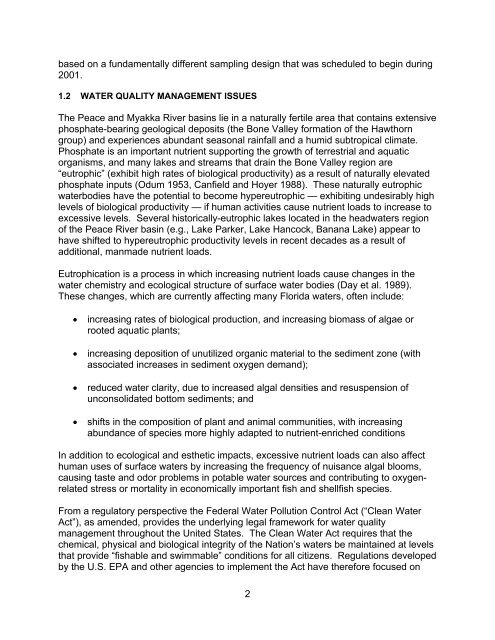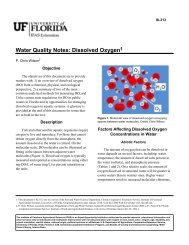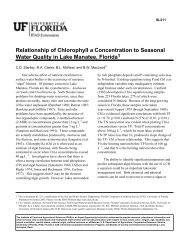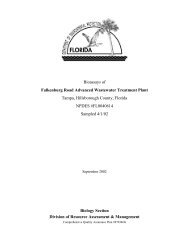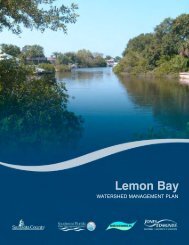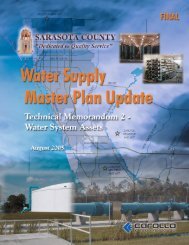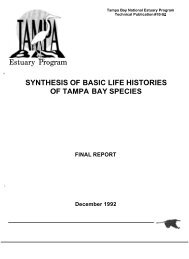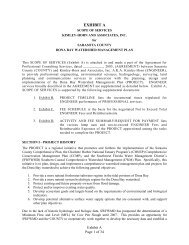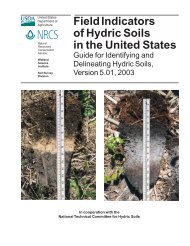Peace and Myakka River Water Quality Summary 2002 - Southwest ...
Peace and Myakka River Water Quality Summary 2002 - Southwest ...
Peace and Myakka River Water Quality Summary 2002 - Southwest ...
You also want an ePaper? Increase the reach of your titles
YUMPU automatically turns print PDFs into web optimized ePapers that Google loves.
ased on a fundamentally different sampling design that was scheduled to begin during2001.1.2 WATER QUALITY MANAGEMENT ISSUESThe <strong>Peace</strong> <strong>and</strong> <strong>Myakka</strong> <strong>River</strong> basins lie in a naturally fertile area that contains extensivephosphate-bearing geological deposits (the Bone Valley formation of the Hawthorngroup) <strong>and</strong> experiences abundant seasonal rainfall <strong>and</strong> a humid subtropical climate.Phosphate is an important nutrient supporting the growth of terrestrial <strong>and</strong> aquaticorganisms, <strong>and</strong> many lakes <strong>and</strong> streams that drain the Bone Valley region are“eutrophic” (exhibit high rates of biological productivity) as a result of naturally elevatedphosphate inputs (Odum 1953, Canfield <strong>and</strong> Hoyer 1988). These naturally eutrophicwaterbodies have the potential to become hypereutrophic — exhibiting undesirably highlevels of biological productivity — if human activities cause nutrient loads to increase toexcessive levels. Several historically-eutrophic lakes located in the headwaters regionof the <strong>Peace</strong> <strong>River</strong> basin (e.g., Lake Parker, Lake Hancock, Banana Lake) appear tohave shifted to hypereutrophic productivity levels in recent decades as a result ofadditional, manmade nutrient loads.Eutrophication is a process in which increasing nutrient loads cause changes in thewater chemistry <strong>and</strong> ecological structure of surface water bodies (Day et al. 1989).These changes, which are currently affecting many Florida waters, often include:• increasing rates of biological production, <strong>and</strong> increasing biomass of algae orrooted aquatic plants;• increasing deposition of unutilized organic material to the sediment zone (withassociated increases in sediment oxygen dem<strong>and</strong>);• reduced water clarity, due to increased algal densities <strong>and</strong> resuspension ofunconsolidated bottom sediments; <strong>and</strong>• shifts in the composition of plant <strong>and</strong> animal communities, with increasingabundance of species more highly adapted to nutrient-enriched conditionsIn addition to ecological <strong>and</strong> esthetic impacts, excessive nutrient loads can also affecthuman uses of surface waters by increasing the frequency of nuisance algal blooms,causing taste <strong>and</strong> odor problems in potable water sources <strong>and</strong> contributing to oxygenrelatedstress or mortality in economically important fish <strong>and</strong> shellfish species.From a regulatory perspective the Federal <strong>Water</strong> Pollution Control Act (“Clean <strong>Water</strong>Act”), as amended, provides the underlying legal framework for water qualitymanagement throughout the United States. The Clean <strong>Water</strong> Act requires that thechemical, physical <strong>and</strong> biological integrity of the Nation’s waters be maintained at levelsthat provide “fishable <strong>and</strong> swimmable” conditions for all citizens. Regulations developedby the U.S. EPA <strong>and</strong> other agencies to implement the Act have therefore focused on2


